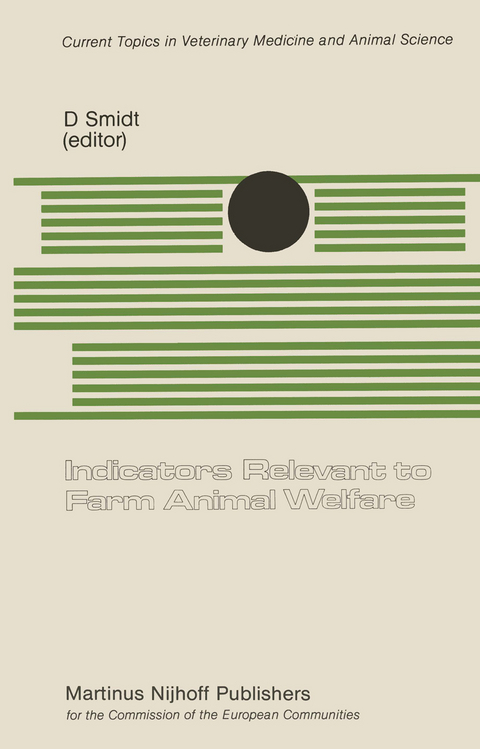
Indicators Relevant to Farm Animal Welfare
Springer (Verlag)
978-94-009-6740-3 (ISBN)
As a result of the seminar, the presently known indicators can be grouped into the following categories : - indicators already being applied to animal welfare assessment in prac- tice, such as morbidity and mortality, technopathies, behavioural aberrations and production performances; - indicators of high sensitivity, such as physiological criteria, which as yet are too demanding for general application; - indicators still under investigation for their reliability. It became also evident that the continuous integration of indicators into canprehensive assessment systems promises an ever improving judgement of animal welfare problems. The proceedings will be of substantial value to the CEC in the pursuit of animal welfare problems.
Session I: General Outline.- Opening Remarks.- Animal Welfare Legislation.- The Problem of Assessing “Well-Being” and “Suffering” in Farm Animals.- Discussion.- Session II: Significance of Indicators Relevant to Animal Welfare.- Physiological, Biochemical and Biophysical Criteria in Assessing Animal Welfare:.- Significance of Physiological Criteria in Assessing Animal Welfare.- Short Contributions:.- Neuroendocrine Strategies for Assessing Welfare: Application to calf management systems.- Corticosteroids in Welfare Research of Laying Hens.- The Sleep-Waking Pattern and Behavior of Pigs Kept in Different Husbandry Systems.- Neurochemistry of Abnormal Behaviour in Farm Animals.- Discussion.- Ethological Indicators:.- On the Significance of Ethological Criteria for the Assessment of Animal Welfare.- Short Contributions:.- Stereotypies as Animal Welfare Indicators.- Ingestive Behaviour and Wing-Flapping in Assessing Welfare of Laying Hens.- Behavioural Tests to Quantify Adaptation in Domestic Animals.- Effect of Social and Environmental Factors on Performance in Gilts, Barrows and Boars.- Operant Conditioning in Farm Animals and its Relevance to Welfare.- Discussion.- Pathological Indicators.- An Ecopathological Approach for Assessing Risk Factors in Intensive Rearing Systems: Examples from Pig Production.- Short Contributions:.- Comparative Mortality and Morbidity Rates for Cattle on Slatted Floors and in Straw Yards.- Pathological Approaches to Evaluate Calf Boxes Under Animal Welfare Aspects.- Results of a Methodical Approach with Regard to External Lesions of Sows as an Indicator of Animal Well-Being.- Discussion.- Production Performance:.- Significance of Production Performance Traits as Indicators of Animal Welfare.- Short Contributions:.- FarrowingAccomodation and Losses, Vitality and Daily Gain of Piglets as Indicators of Well Being.- Production Performance in Laying Hens Kept Under Different Housing Conditions.- Discussion.- Session III: Integrated Systems of Indicators Relevant to Animal Welfare.- Advantages and Problems of using integrated Systems of indicators as compared to single traits.- Short Contributions:.- Assessing of Housing Systems by Combined Indicators.- Application of an Integrated System of Indicators in Animal Welfare Research.- Discussion.- Session IV: Applicability of Indicators in Animal Welfare Research and in Control Procedures.- Applicability of Indicators in Animal Welfare Research.- The use of Ethological Welfare Indicators in Practical Control Procedures.- Discussion.- General Conclusions.- List of Participants.
| Reihe/Serie | Current Topics in Veterinary Medicine ; 23 |
|---|---|
| Zusatzinfo | IX, 251 p. |
| Verlagsort | Dordrecht |
| Sprache | englisch |
| Maße | 156 x 244 mm |
| Themenwelt | Naturwissenschaften ► Biologie ► Ökologie / Naturschutz |
| Naturwissenschaften ► Biologie ► Zoologie | |
| Veterinärmedizin | |
| ISBN-10 | 94-009-6740-3 / 9400967403 |
| ISBN-13 | 978-94-009-6740-3 / 9789400967403 |
| Zustand | Neuware |
| Haben Sie eine Frage zum Produkt? |
aus dem Bereich


